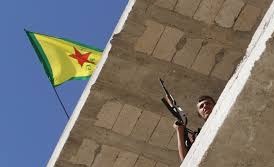
RNA - The self-styled caliphate has been in rapid decline since allied forces of Iran, Syria, Russia and Hezbollah liberated several towns and villages in northern Syria. But if the US-backed Kurdish militias refocus their efforts on acts of autonomy in the north, victory may be short lived.
It has been a bad few months for ISIL. For the first time since the terror group laid claim to much of Iraq and Syria, it no longer has a direct path to Europe. Black flags are no longer flying over towns and villages near the Turkish border, and the foreign-backed marauders are on the run. The decay continues and ISIL will soon lose its remaining foothold in Syria. Its last bastion is Raqqa and the north-eastern deserts, where it all began, and from where much of its subsequent rampage was plotted – with a helping hand from outside actors.
However, little about what comes next is clear. The group’s loss of territory has shifted geopolitical ground in ways that could not easily have been predicted. And, in the eyes of the Syrian government and allies, the danger has metastasized into a new threat that the end of ISIL won’t mitigate:
1) On balance, occupation leads to compliance and autonomy leads to engagement of outside powers. It would be very hard for the occupying US troops to have a permanent base in Syria after the ISIL war; that is, unless the Pentagon regime has proxy forces. If the US wants to occupy the northern parts of Syria permanently, or wants its illegal bases there to be recognized by the international community, it will have to convince the world that Syria’s Kurds cannot survive without US occupying forces.
2) President Trump insists that Russia needs to “rein in the Assad regime, Iran, and Iranian proxies” in Syria, which suggests his shift toward calling for regime change when he attacked a Syrian airbase last month appears largely unchanged. The Trump administration has also suggested that the sanctions regime is going to remain in place until “Assad goes,” which is to say forever.
3) For Iran, Syria and Russia, the focus now is primarily on the de-escalation zones, a plan which the Trump White House had previously been in favor of, but which since Iran and Syria backed it, they are now extremely evasive about their position on. Washington’s terror proxy forces have also ruled out respecting the de-escalation zones, though Iran, Russia, Turkey, and the Syrian government will respect them.
4) The Syrian Kurdish YPG forces are cheering Trump’s announcement that the US will be directly providing them with more advanced heavy weaponry, saying the decision would bring “positive, big, and fast results.” And by results, they mean a quicker route to US-backed autonomy – with or without defeating ISIL in Raqqa and elsewhere.
5) The YPG sees this as giving them a more influential role in post-war Syria, which is likely to mean more YPG ambitions for taking territory away from Syrian forces – with a helping hand from American warplanes - to add to their own autonomous region. This has been a growing concern as US-backing has allowed the Kurdish militias to expand well outside of historic western Kurdistan, first taking some Arab villages in the surrounding area, and now taking some pretty significant cities, which it full expects to keep within an autonomous zone.
The conclusion is that the establishment of this large, autonomy-minded Kurdish militia faction with a large cache of US weapons is likely to be a major threat to Syria’s future long after the current war. The latest developments offer all the clues we need:
US-backed YPG forces have just announced they have full control over the town of Tabqa, and the nearby hydroelectric dam. They insist the town is now completely liberated. Tabqa is also the biggest town the YPG has captured in a while, as other than their capture of the city of Manbij, most of their offensives have focused on tiny villages that happen to be in theoretically valuable areas.
All in all, this potentially marks a crucial change in the political geography of the Middle East. In effect, the US is choosing to support its Kurdish proxies in Syria, in defiance of Iran, Russia, Syria, and Turkey, whose aim is to prevent the establishment of a pro-US autonomous Kurdish region in northern Syria.
In the prevailing environment, Ankara is wasting time to persuade the US to break its alliance with the YPG. Ankara claims that the YPG is the Syrian arm of the Kurdistan Workers’ Party (PKK) that has been waging a guerrilla warfare against the Turkish state since 1984. Turkish Foreign Minister Mevlut Cavasoglu claims that “both the PKK and the YPG are terrorist organizations and they are no different, apart from their names”.
In sum, every American weapon supplied to the Kurdish militias is not only a threat to Turkey, but also a threat to Syria, Iraq, Iran, and the Kurdish populations themselves. Turkey’s decision to step up military engagement in northern Syria and to target the Kurds is not the right response to this developing threat. The four neighbors should focus their attention on US threats and regional designs instead. They should embark on a regional dialog to persuade their Kurdish citizens to stick with them and not with the US occupying troops who have no intention to resolve Kurdish security concerns, much less to stop running contrary to Kurdish interests.
847/940